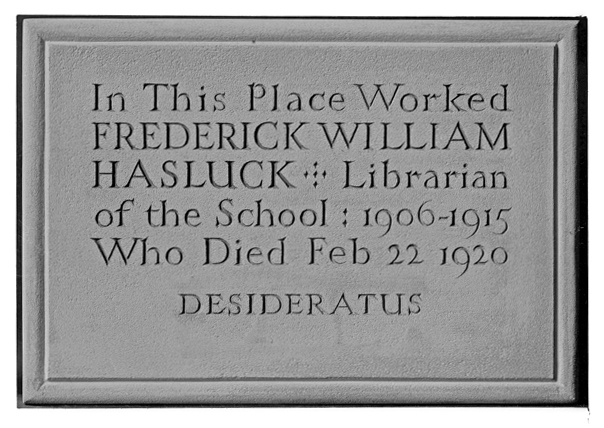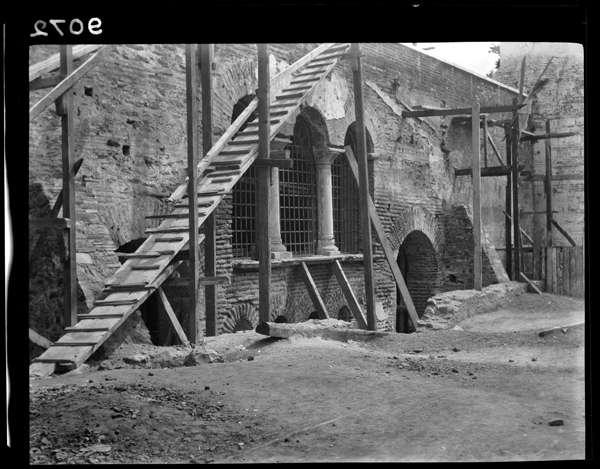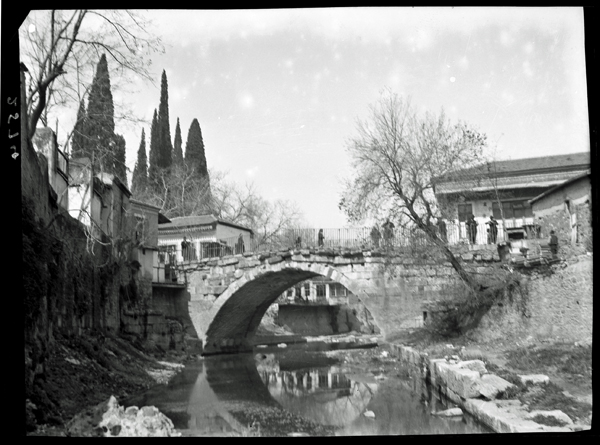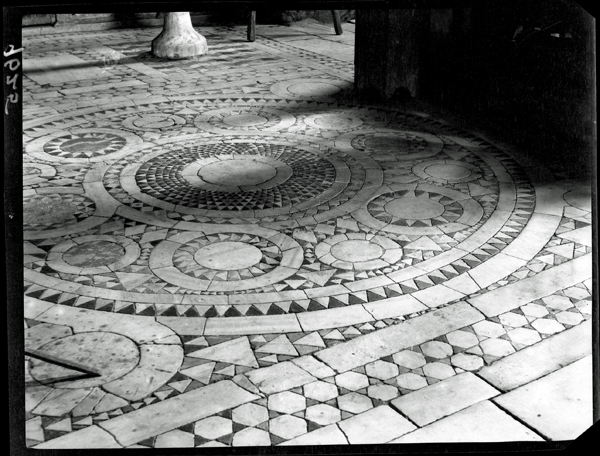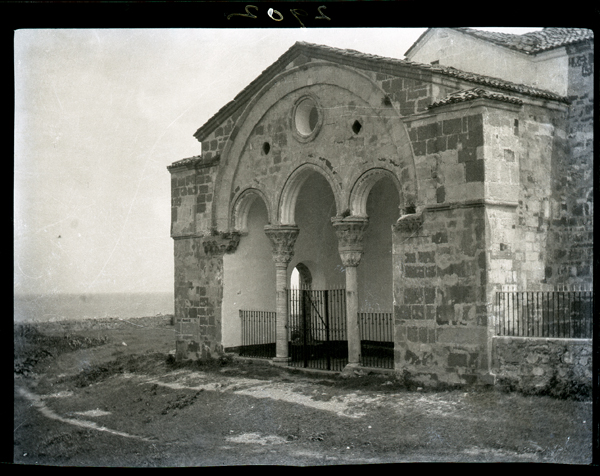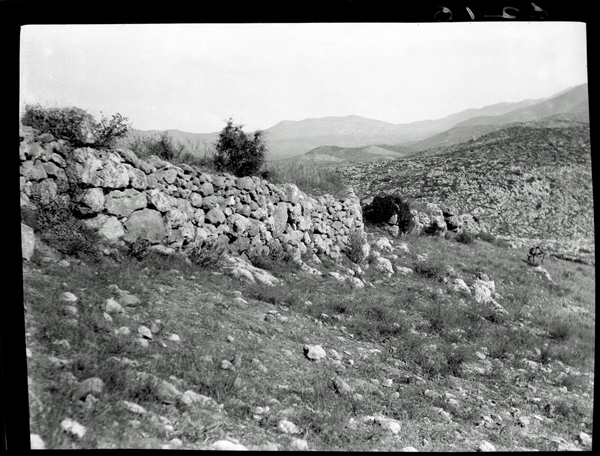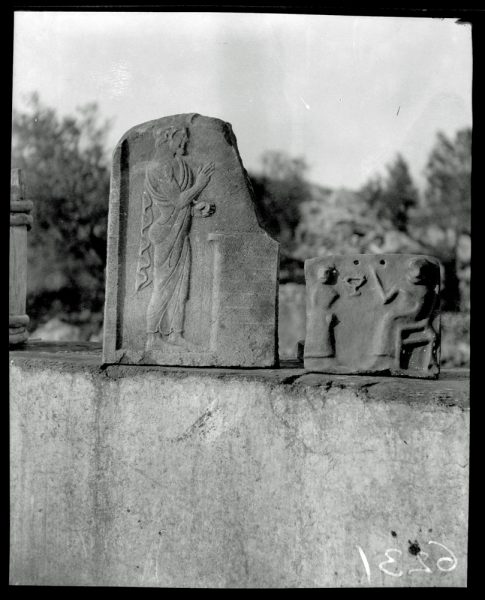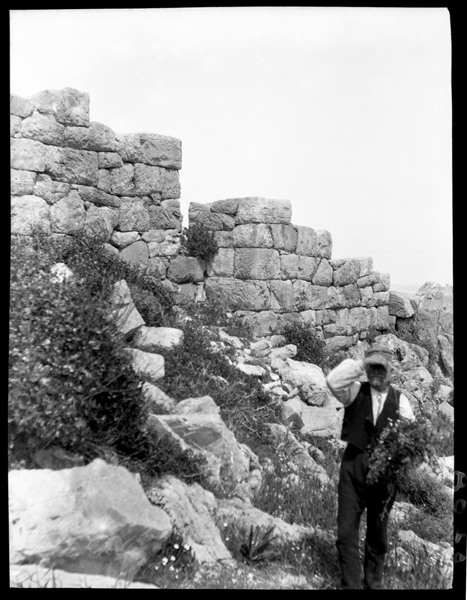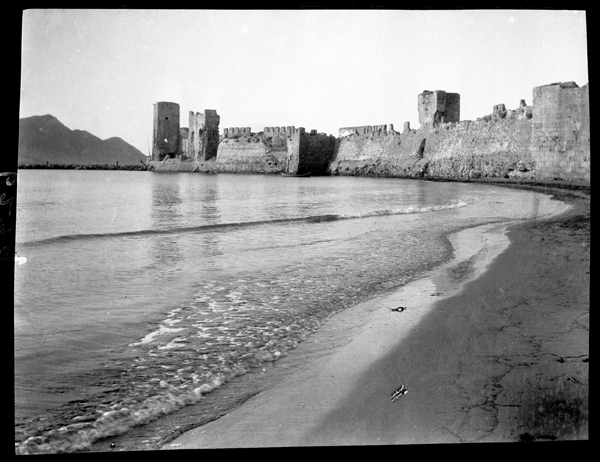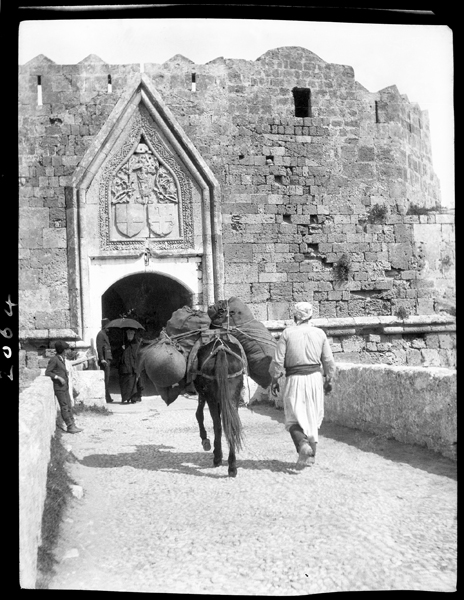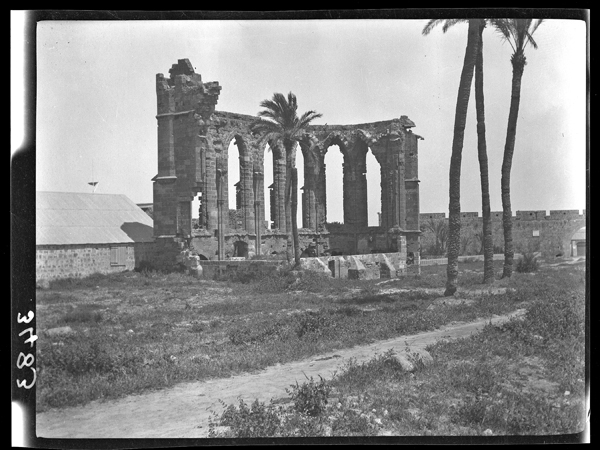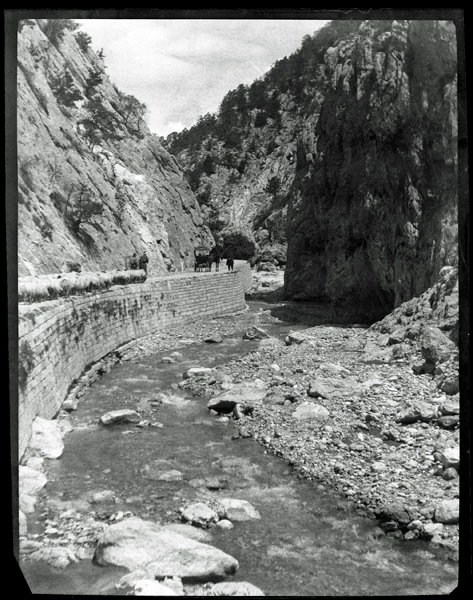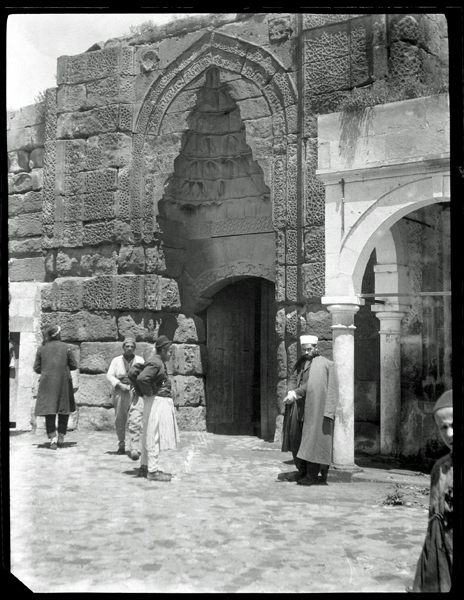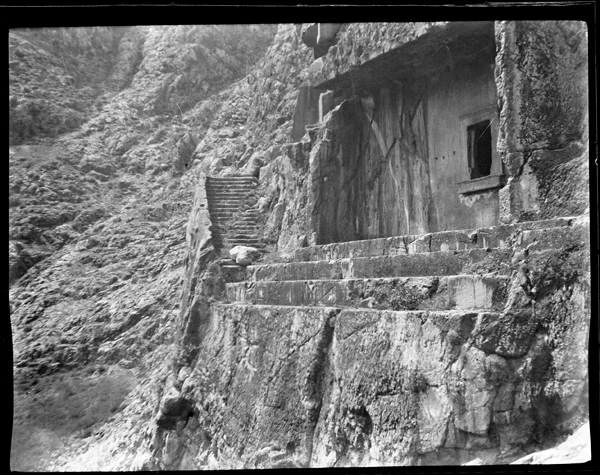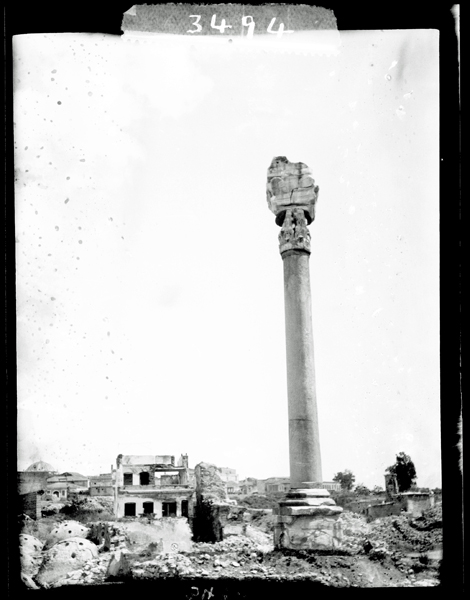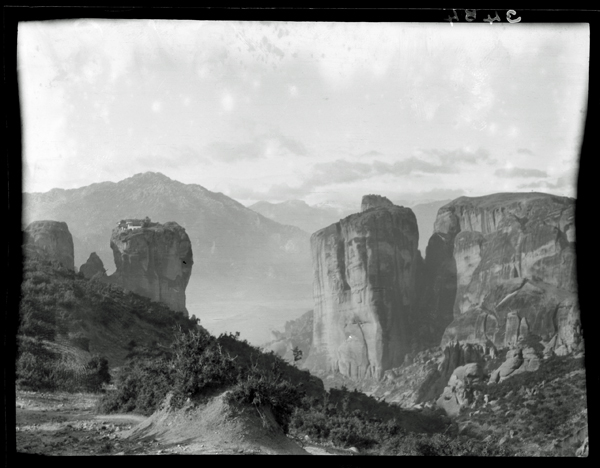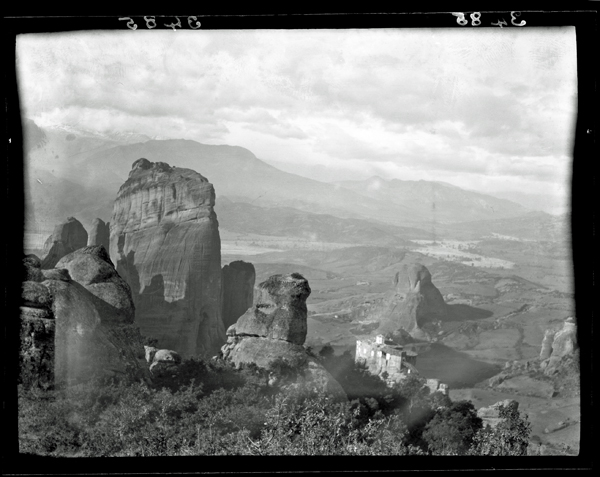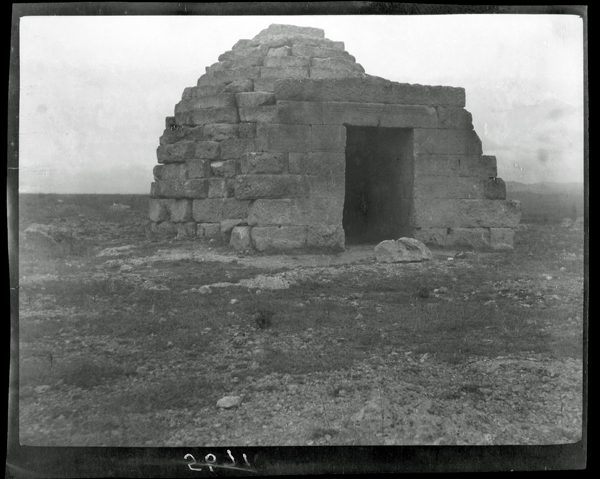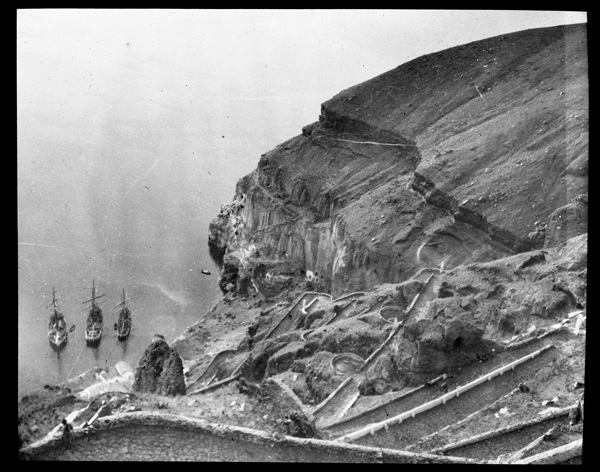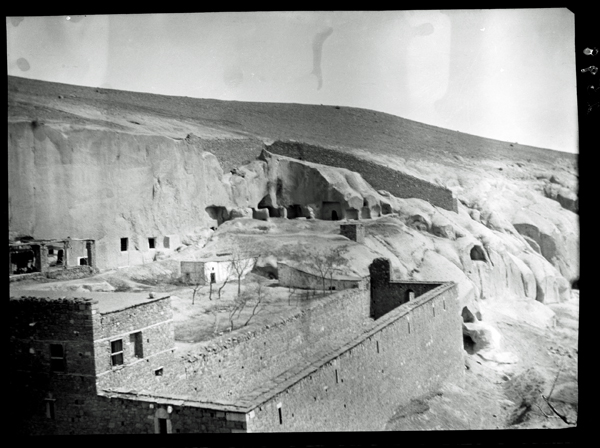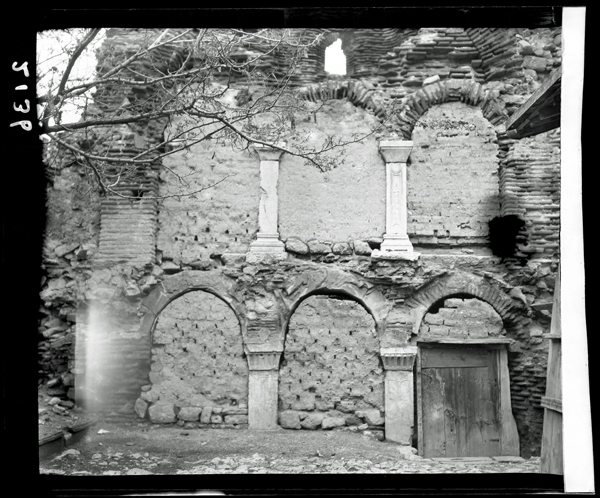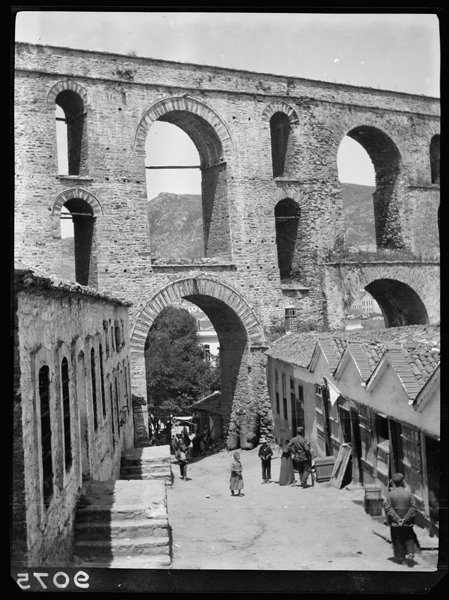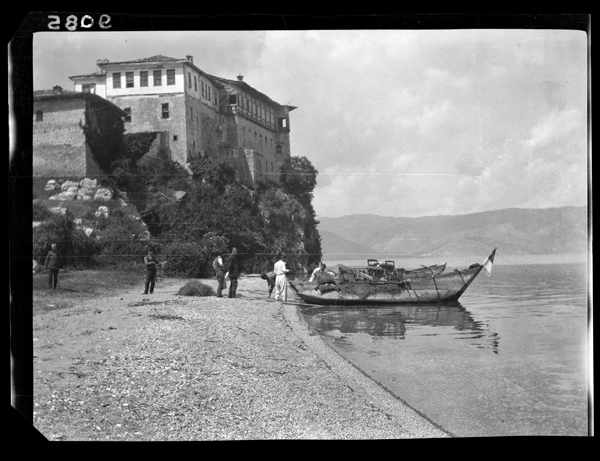The Well-travelled Frederick W. Hasluck: Images from the SPHS Collection
One of the most well-travelled scholars associated with the British School at Athens (BSA) was Frederick W. Hasluck. His association with the BSA began with his admission as a student scholar in 1901, readmitted annually in that capacity until 1906 when he became the BSA’s Assistant Director and Librarian. He served in these two roles from 1906 to 1915 and acted as Director in 1911 when R.M. Dawkins was on leave. During his time at the BSA, Hasluck travelled often and widely, furthering his understanding of parts of Asia Minor, the Balkans, and Greece. He regularly (and promptly) published observations he made during these tours in the Annual of the British School at Athens and occasionally in The Journal of Hellenic Studies.
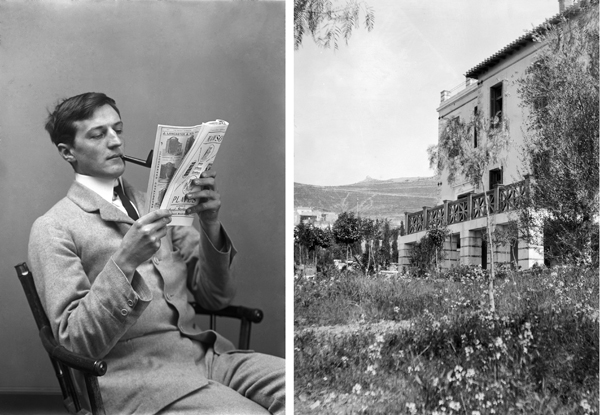
Left: BSA SPHS 01/2354.6266. F.W. Hasluck reading a photographic catalogue ca. 1908. Right: BSA SPHS 01/2353.6265 Photography by Hasluck of the BSA Hostel building (undated).
Hasluck began his fieldwork career at the BSA surveying the ancient city of Cyzicus with Arthur Edward Henderson in 1902, the topic of a previous Archive Story, The Cyzicus Question. The advent of WWI brought his travelling to an end. However, during the war years, Hasluck (whose health had begun to deteriorate) continued to work from the BSA library helping to coordinate counter-espionage efforts for British Intelligence, headquartered at the BSA. The author Compton Mackenzie, who had been the Special Intelligence Bureau representative for the Eastern Mediterranean, fulsomely praised Hasluck in his book, Greek Memories, as a fine scholar with an accurate, patient and logical mind and an invaluable asset in the War effort. In 1916, he was diagnosed with tuberculosis, retired to France and eventually moved to a sanatorium in Switzerland. Tragically, Hasluck died in 1920, a few days after his 42nd birthday. A small plaque in the library is dedicated to him, marking his presence as a notable BSA figure.
The photographic collection of the Society for the Promotion of Hellenic Study (SPHS) received regular contributions from Hasluck, often in the form of original film negatives illustrating many of his activities between 1902 and 1915. In 2003, a selection of SPHS negatives, slides and prints came to the BSA and now comprise the BSA-SPHS Image Collection. There are nearly 700 extant photographs in this collection from Hasluck. They record many, but not all, of Hasluck’s archaeological, historical and ethnographic studies during this time. The first images in the collection donated by Hasluck are of his work at the ancient city of Cyzicus and his survey of the surrounding area.
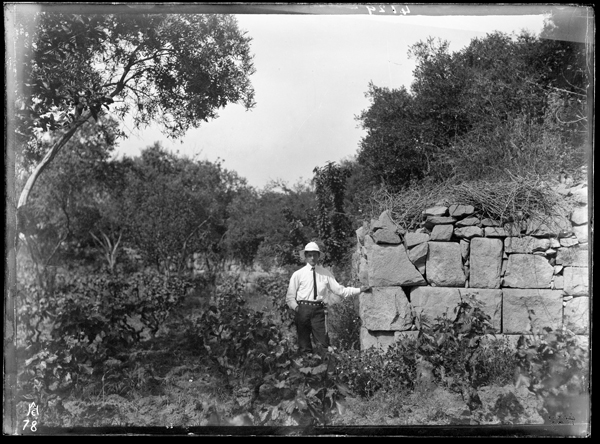
BSA SPHS 01/1654.4129. Cyzicus fortifications: E. wall and gate near Amphitheatre with F.W. Hasluck for scale (1902)
It should be noted, however, that Hasluck’s negatives are briefly captioned and most do not contain specific dates. Context and dates can be assigned to the images by examining groups of images catalogued in the SPHS negative register and coordinating them, wherever possible, with activities recorded in the BSA Annual Reports or accounts found in published articles based on places shown. This is not a precise method of assigning context as negatives were assigned sequential catalogue numbers and listed in the SPHS registers when accessioned into the collection by SPHS photographic library volunteers, not necessarily listed in the order in which they were photographed. More precise dating – terminus ad quem – evidence occurs if an the image was published or if the negative was reproduced as a slide and was listed in one of the published accession lists to the SPHS slide collection. Very rarely, an exact date is listed in the caption in the register, such as 1914 in the caption of the Church of the Acheiropoietos in Thessaloniki.
The first images in the collection donated by Hasluck are of his work at the ancient city of Cyzicus and his survey of the surrounding area, dating from 1902 to 1907. Many of the images of the ancient city are copies of photographs taken by A.E. Henderson, but numerous negatives of the surrounding area were by Hasluck. In addition to his exploration around the area of Cyzicus and the Marmara Islands, Hasluck proceeded further afield into parts of Asia Minor. During that time, in 1906, he travelled with J.M. Dawkins (younger brother of R.M. Dawkins) to sites from Smyrna, Balukiser, Brusa to Nicaea. In addition to his 1907 survey of the Marmara Islands, he toured various Hellespontne sites with J. Baker Penoyre who had just concluded his survey of the island of Thasos (see Surveying Thasos) and began a study of Byzantine monuments (churches, fortresses and inscriptions), focusing particularly on several churches in the town of Tirilye and the church of the Metamorphosis on the island of Kalolimno (modern İmralı; ancient Besbicus). In 1908, he also made a visit to sites in Northeast Anatolia which included the Pontic town of Trabzon where he photographed the 13th century church of Ayia Sophia that had been converted into the mosque of Ayasofya in 1584.
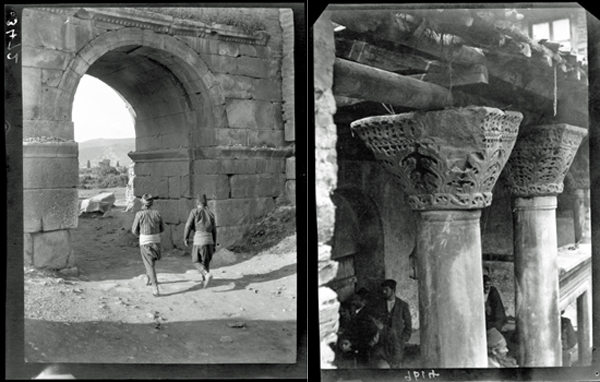
Right: BSA SPHS 01/1360.3472. Nicaea: Inner Yenishehr gate (1906); Left: BSA SPHS 01/4668.9614. Tirilye: Detail of the Bithynia mosque Faith mosque, formerly church of Evangelistria (1907)
Even while Hasluck was pursuing his own interests in Asia Minor, he participated in projects based in Laconia that preceded the BSA’s major excavations in the Sparta region (1906-1910). The year before excavation began, in 1905, Hasluck and Alan Wace extensively surveyed parts of Laconia, covering East-Central and Southeastern Laconia to Cape Malea. Wace and Hasluck also conducted a small exploratory excavation at Geraki, expecting to find a temple, and disappointed when all they uncovered were ‘Pelasgian’ walls of an ancient town. They also conducted a small excavation at Angelona near Monemvasia, finding evidence of a rural sanctuary, based on a chance discovery of a marble relief by the farmer who owned the land. Also in 1905, Hasluck supervised Austrian Surveyor, Mr Sejk (who would later provide a state plan for the start of the Sparta excavations) in creating plans for the ancient fortresses at Zarax and Epidauros Limera on the east coast of Laconia.
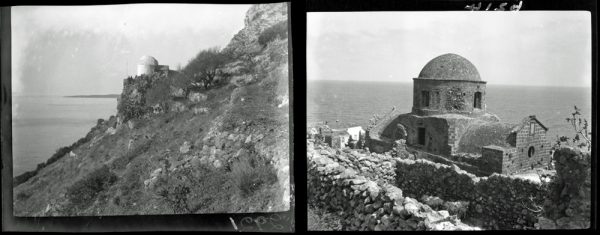
Left: BSA SPHS 01/1103.2921. Cape Malea, Ayia Eirini Monastery; Right: BSA SPHS 01/3781.6214. Monemvasia: Panagia Kritikia, also known as Panagia Myrtidiotissa (1905)
Concluding his study of the Cyzicus district and with no further obligations in Laconia, Hasluck was free to develop an interest in Frankish monuments. On Chios, from 1907 to 1909 he studied the various monuments dating from the Genoese occupation, publishing his observations in 1909. According to the BSA Annual Report, between visits to Chios, Hasluck spent part of 1908 visiting Lesvos, Aenos (modern Enez), Lemnos, and Phocaea (modern Foça) documenting the medieval remains of the Gattelusi. Also in 1908, he spent some time in Messenia, photographing the Venetian stronghold at Methone. The following year Hasluck travelled with A.M. Woodward to Rhodes and later to Southwest Asia Minor, the subject of a previous Archive Story (Hasluck and Woodward in S.W. Anatolia), publishing on the Frankish remains from Antayla. While in Rhodes, Hasluck also photographed the medieval monuments on the island.
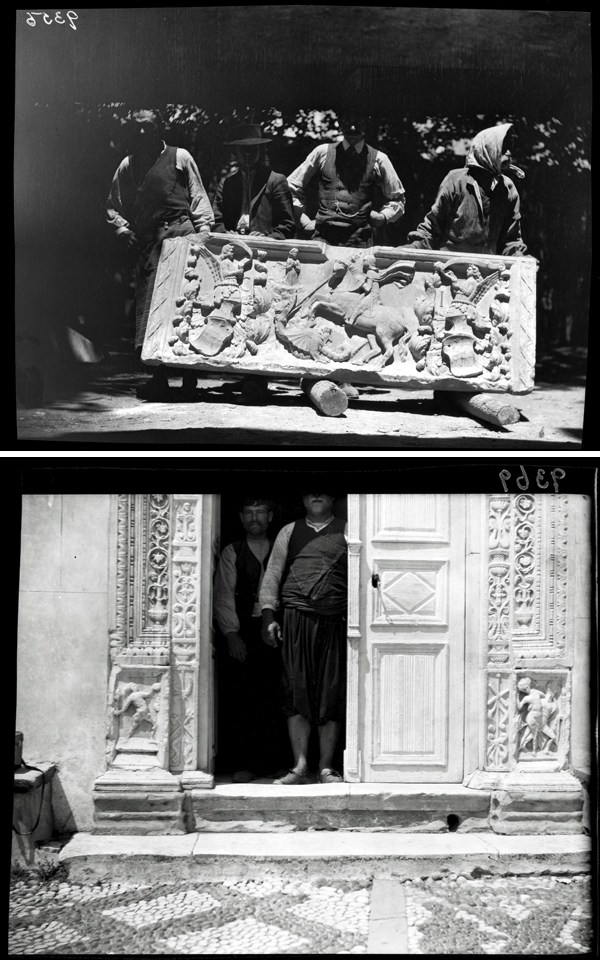
Top: BSA SPHS 01/4550.9356. Chios (town): Museum, Lintel relief of St. George. (1909)
Bottom: BSA SPHS 01/4561.9369. Chios, Chalkio: Detail of jambs of the Genoese doorway of the village church (1907/1909)
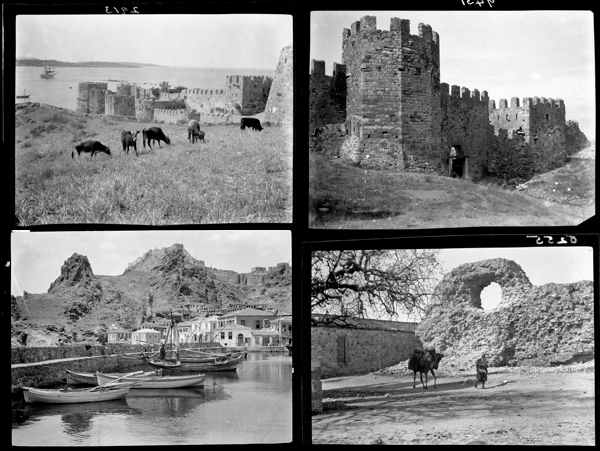
Top left to right: BSA SPHS 01/1095.2913. Lesvos, Mitylene, walls of the kastro tower and north harbour; BSA SPHS 01/4592.9431. Aenos (modern Enez) main gate. (1908)
Bottom left to right: BSA SPHS 01/1133.2952. Lemnos, Myrina, harbour and kastro; BSA SPHS 01/2344.6255. Phocaea (modern Foça), fragment of a Genoese wall, land side. (1908)
Hasluck took an academic year’s leave of absence (1909-1910) from his duties as Assistant Director at the BSA. Much of his leave time was spent travelling in India (for which there are no photographs in the SPHS collection) and later Cyprus where he spent three weeks touring Larnaca, Nicosia, Kyrenia, and Famagusta. From Cyprus, he crossed over to Mersin, starting at the Cilician Gates and proceeded to bisect Central Anatolia. He travelled by rail to Nigde then on to Caesarea Mazaca (modern Kayseri), Sivas, Tokat, and Amasya as well as short diversions to the rock-cut monuments of Soghanli and Göreme – around the same time that R.M. Dawkins was beginning his study in that area on Greek dialects (see Documenting Modern Greek Dialects).
Near the end of this 1910 trip, he sailed from Samsun on the Pontic coast to Constantinople. Here he photographed monuments such as the Aqueduct of Valens and Column of Marcian which had recently been made accessible by fires. It is probable that he also made a systematic photographic study of the walls of Constantinople at this time.
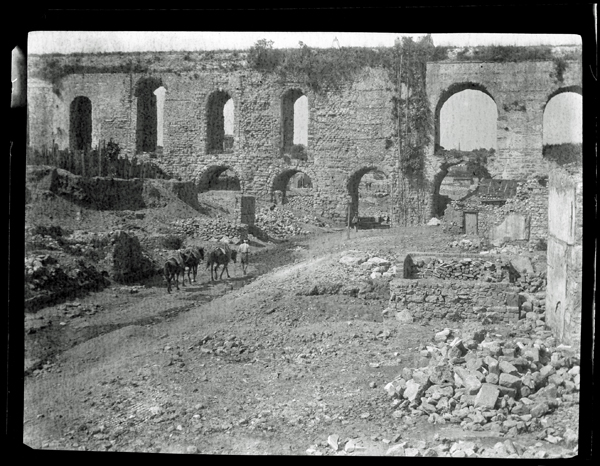
BSA SPHS 01/1154.2972. Constantinople: Valens Aqueduct (1910).
The SPHS register contains a note by Hasluck: “It is rarely accessible, the whole quarter has been ruined by fire lately”.
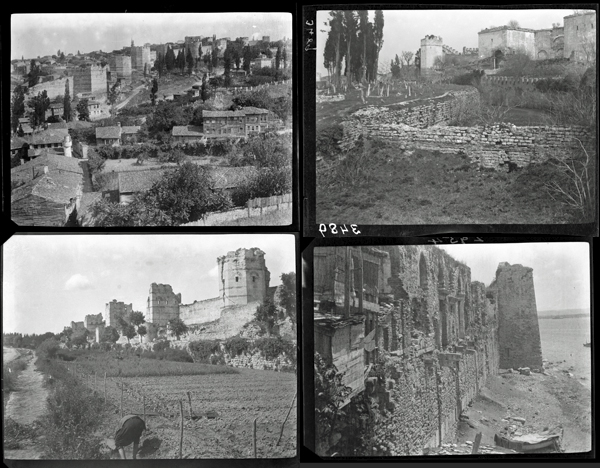
Top left to right: BSA SPHS 01/1145.2963. Constantinople land walls at Ayvansaray; BSA SPHS 01/1377.3489. Constantinople: the Golden Gate showing the cross wall of the moat. (1910?)
Bottom left to right: BSA SPHS 01/1142.2961. Constantinople land walls between the Yedikule Fortress and Topkapi Palace; BSA SPHS 01/1135.2954. Constantinople seaward wall in front of Bucoleon Palace. (1910?)
Hasluck spent some time at Meteora during the winter of 1910/1911. There are two photographs of Meteora donated by Hasluck in the BSA SPHS Collection. They are both distant shots – one of Rousanou Monastery and the other of Hagia Triada Monastery. The photographs may date to this period, but according to the BSA Annual Reports, Hasluck returned for a short time to Meteora in 1914.
Prior to his visit to the Holy Mountain of Athos, in the spring of 1911, Hasluck organised a tour with Walter Leaf to visit the Troad and Hellespontine sites. There are no photographs from Hasluck on this tour. However, while en route to these areas, Hasluck took the opportunity to investigate the architecture of a Thracian tomb at Kirk Kilisse. It was published that same year.
Hasluck’s visit to Mount Athos in 1911 is documented in the Archive Story F.W. Hasluck and the Monasteries of Athos. In March 1912, Hasluck conducted a tour of Thera with members of the BSA. Later in 1912, he intended to investigate areas of Thrace, but, according to the BSA Annual Report for that year, he ran into difficulty with Turkish authorities in Viza and, with the aid of the H.B.M. Consul, went to Constantinople. From Constantinople, he travelled to the islands of Samos, Patmos and Leros. He was said to have gone to the sites of Didyma, Miletus, Priene and Scala Nuova, although the SPHS does not have Hasluck’s images from these latter sites.
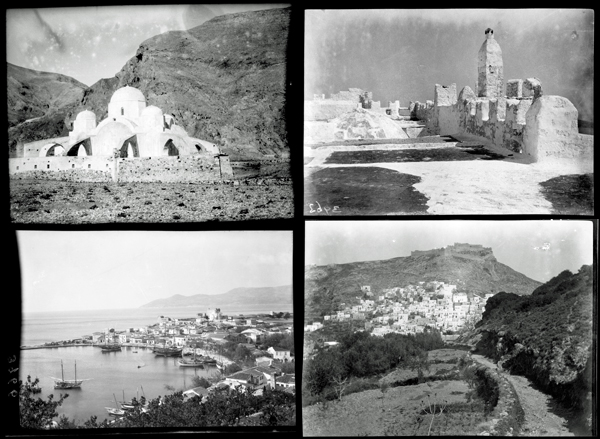
Top left to right: BSA SPHS 01/1555.3987. Perissa (Thera): 1840 neo-Byzantine church of Stavros; BSA SPHS 01/1532.3963. Patmos, Monastery of Saint John the Theologian: Battlements (1912)
Bottom left to right: BSA SPHS 01/1535.3966. Samos, Pythagorio: Harbour; BSA SPHS 01/1539.3970. Leros, Ayia Marina: Village and castle hill (1912)
Hasluck married BSA student Margaret Hardie in September 1912 and the couple spent their honeymoon in Konya in the spring of 1913. It was in Konya which was to be a turning point his his researches where he became interested in the interplay between Christianity and Islam. The SPHS collection contains several photographs of the Monastery of St. Chariton in Sille (Konya) from this visit. Later in 1913, Hasluck visited Ankara (Angora) to make a special study of the ‘churches of Angora’. Images of the scant remains of Ankara’s church of St. Clement were presented to SPHS by Hasluck that same year.
In his last year of long-distance travel before the onset of WWI, Hasluck visited the northern towns of Thessaloniki and Kavala. Further north, into Northern Macedonia, Hasluck went to Lake Ohrid where he photographed the church of St. Sophia and the Monastery of Saint Naum. This was at a time he was studying the Bektashi, a wide-spread order of dervishes which incorporated aspects of other mystery cults. The Christian monastery on the lake was considered a place of pilgrimage for the Bektashi as it contained the tomb of the Slav saint Naum who was said to have been identified with the legendary dervish saint, Sari Saltik.
Near the end of his career, Hasluck increasingly focused on religious beliefs which is reflected in his later photographs of churches, mosques and monasteries. There were inklings of this in his early study of Byzantine churches in Bithynia in 1907. His interests lay in interactions between Christian myths and Islamic tradition, primarily displayed in Turkish folklore. This interest culminated in his posthumously published two volume work, Christianity and Islam under the Sultans. The work was edited by his wife, Margaret who summed up her husband’s career in the preface:
My husband spent most of his life from 1899 to 1916 in Greece and Turkey. During the first fourteen years of this period, working as an archaeologist rather than as an orientalist, he studied at various times the classical archaeology of Greece, the medieval and modern history of Smyrna, the rise and development of the Orthodox monasteries of Mount Athos, the records of medieval geography and travel in the Near East, and the Genoese and Venetian coins and heraldry found in that area. The fruits of these studies were several books and some fifty articles.
Hasluck’s close friend R.M. Dawkins wrote a character sketch of Hasluck in his unpublished autobiographical notes (held in the Bodlein Library at Oxford). Dawkins admits that it was Hasluck who influenced his interest in folklore and popular religion. During the last few years of Hasluck’s life until 1920, Dawkins corresponded with Hasluck on these subjects. These letters were later edited by Margaret Hasluck and published posthumously in 1926. Dawkins goes on to say that ‘it would be difficult to estimate how much I was benefited by this close contact with a mind in many ways so very different from my own and yet bent on the same studies and with the same interests’. One major difference was Dawkins’ interest in the natural world. He observed Hasluck’s ‘indifference to the beauties of nature and scenery’ remarking that ‘the only place he could really forgive for not being paved was the garden of his parents house at Southgate’. Dawkins speculated that Hasluck would have disliked the numerous botanical observations and accounts of scenery in Dawkins’ own 1936 book on Mount Athos, even though Dawkins’ trips to the Holy Mountain in the 1930s were inspired, in part, by Hasluck. It is not surprising that most of Hasluck’s photographs depict the built environment: buildings, walls and other manmade objects. There are very few landscape views. Dawkins also indicated that it was Hasluck’s extensive ‘sympathetic’ travels in Greece and particularly Turkey, his fluency in Greek and Turkish, his encyclopedic knowledge of Near Eastern travel literature, and his uncanny research abilities that led to solid understanding of the subjects he studied and meticulously recorded in his photographs.
Deborah Harlan
British School at Athens
Images from the BSA-SPHS collection are available on the BSA’s Digital Collections page.
Click here for more BSA Archive Stories.
Further Reading:
| Dawkins, R.M. | |
| 1936 | The Monks of Athos. London : G. Allen & Unwin |
| Hasluck, F. W. | |
| 1901-1902 | ‘Sculptures from Cyzicus’, The Annual of the British School at Athens, 8: 190–196 |
| 1902 | ‘An Inscribed Basis from Cyzicus’, The Journal of Hellenic Studies, 22: 126–134 |
| 1903 | ‘Inscriptions from Cyzicus (Continued)’ The Journal of Hellenic Studies 23: 75-91 |
| 1904 | ‘Unpublished Inscriptions from Cyzicus Neighbourhood’, The Journal of Hellenic Studies 24: 20-40 |
| 1904-1905 | ‘Note on a Lion-Group from Cyzicus’, The Annual of the British School at Athens, 11: 151–152 |
| 1905-1906 | ‘A Roman Bridge on the Aesepus’, The Annual of the British School at Athens, 12: 184–189 |
| 1906-1907 | ‘Bithynica’, The Annual of the British School at Athens, 13: 285–308 |
| 1908-1909 | ‘Monuments of the Gattelusi’, The Annual of the British School at Athens, 15: 248–269 |
| 1908-1909 | ‘Frankish Remains at Adalia’, The Annual of the British School at Athens, 15,:270–273 |
| 1909 | ‘The Marmara Islands’, The Journal of Hellenic Studies, 29: 6–18 |
| 1909-1910 | ‘The Latin Monuments of Chios’, The Annual of the British School at Athens, 16: 137–184 |
| 1909-1910 | ‘A French Inscription at Adalia’, The Annual of the British School at Athens, 16: 185–186 |
| 1910-1911 | ‘A Tholos Tomb at Kirk Kilisse’, The Annual of the British School at Athens, 17: 76–79 |
| 1911 | ‘Genoese Lintel-Reliefs in Chios’, The Burlington Magazine for Connoisseurs, 18(96): 325+328-330 |
| 1912-1913 | ‘Christianity and Islam under the Sultans of Konia’ The Annual of the British School at Athens 19: 191-197 |
| 1914-1915, 1915/1916 | ‘Geographical Distribution of the Bektashi”, The Annual of the British School at Athens 21: 84-124 |
| 1924 | Athos and its Monasteries. London: Kegan Paul |
| 1926 | Letters on Religion and Folklore. Edited by M. M. Hasluck. London: Luzac & Co. |
| 1929 | Christianity And Islam Under The Sultans (2 vol). Oxford: Clarendon Press |
| Hasluck, F. W. and Henderson, A. E. | |
| 1904 | ‘On the Topography of Cyzicus’, The Journal of Hellenic Studies, 24: 135–143 |
| Mackenzie, C. | |
| 1939 | Greek Memories, London: Chatto and Windus |
| Wace, A. J. B. and Hasluck, F. W. | |
| 1904-1905 | ‘Laconia: I. Excavations near Angelona’, The Annual of the British School at Athens, 11: 81–90 |
| 1907-1908 | ‘Laconia: II.-Topography’, The Annual of the British School at Athens, 14: 161–182 |
| 1908-1909 | ‘Laconia: II. Topography’, The Annual of the British School at Athens, 15: 158–176 |
| Wace, A. J. B., Hasluck, F. W. and and Tillyard, H. J. W. | |
| 1904-1905 | ‘Laconia: II. Geraki’, The Annual of the British School at Athens, 11: 91–123 |
